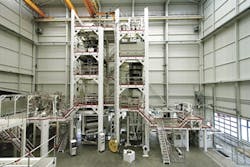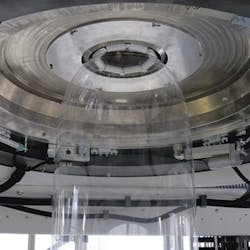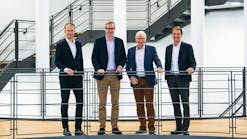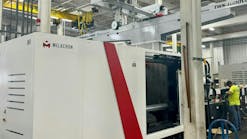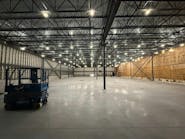A proprietary process that allows manufacturers to produce multilayer, biaxially oriented barrier films has been upgraded.
Once capable of producing only relatively narrow films, the triple-bubble process from Kuhne Anlagenbau GmbH in Sankt Augustin, Germany, initially was used to make barrier shrink bags and sausage casings. But thanks to enhancements, it's now applicable for use with even more products, said Adolfo Edgar, Kuhne's VP of blown and film systems for the U.S. and Canada.
One of Kuhne's oldest triple bubble customers — Gomji Milanovac, Serbia-based Spektar Co. —has watched the technology evolve over time, and earlier this year invested in the latest technology.
"Our cooperation with Kuhne started in 1992, when we purchased the first triple-bubble line to produce polyamide (PA) casings for packaging food products like semi-boiled sausages and salamis," said Olivera Matovic, one of the company's co-owners. "The fact that we got to know the technology from the very beginning of its development helped us to become more and more familiar with it. Every new line we purchased allowed us to improve existing products and develop new ones."
A triple-bubble line that produces bioriented flat films for high-barrier packaging, for example, can now produce film as wide as 55 inches. Kuhne plans to be producing film that's 70 or more inches wide in the next few years.
"It didn't come as the result of any major breakthrough," Edgar said. "We overcame the problem of limited film widths gradually over the years, as our understanding and familiarity with the process increased and improvements were made in the machinery's technology."
How the Triple-Bubble Process Works
The majority of coextruded barrier films produced today have seven, nine or 11 layers and are not biaxially oriented. Incorporating biorientation into the barrier film coextrusion process offers improved optical, barrier and mechanical properties, and increasing the number of layers to 13 enables the production of upgraded structures, such as having a single film with ethylene vinyl alcohol (EVOH) as an oxygen barrier, PP as a moisture barrier and PET for puncture resistance.
It also provides greater flexibility because having 13-layer capabilities doesn't mean the user is necessarily producing a film with 13 layers; it can produce a seven- or nine-layer structure with different ratios of materials.
"For example, if a thick layer is required, you can use three extruders to produce that layer," Edgar explained. "If that layer in a different application has to be thin, then you use only one extruder to produce it."
If the sizes of the extruders are already fixed — as they would be in a seven-layer line, for example — it is impossible to produce a thin layer with a big extruder or a thick layer with a small extruder because the pressure would be too high or too low.
A Kuhne line produces biaxially oriented barrier films in three stages, each of which takes place in a separate tower.
In the first stage, a bubble is produced by the downward extrusion of a tube with a 1:1, or slightly negative, blow-up ratio. It is water-quenched to give it an amorphous structure and very low crystallinity; the amorphous structure is crucial because it's what makes the subsequent biorientation possible, in addition to giving the final product an attractive, high-quality look.
After it's cooled, the film is routed to the top of the second tower, where it is formed into a second bubble resembling a wine bottle. The neck of the bottle has the same diameter as the first bubble and is reheated by infrared (IR) heaters; during this time, no machine direction (vertical) orientation is imparted to the film. After reheating is complete, the film is given a simultaneous biaxial (horizontal and vertical) orientation, which results in slightly better properties in the final product than sequential orientation provides.
"One of the biggest advantages of simultaneous orientation is that it allows the use of resins that do not biorient sequentially," Edgar said. "For example, very-high-barrier EVOH resins will not biorient sequentially but can be used without a problem in the triple-bubble process, which results in a higher oxygen barrier in the final film."
During this second stage, air pressure inside the bubble is about 30 pounds per square inch. In the third stage, the now-bioriented second bubble is routed to the top of the third tower, where it is reinflated to the same diameter as the "wine bottle" body of the prior stage — but at a lower pressure — and heated again by IR heaters. This process, known as annealing or thermofixation, stabilizes the film structure and determines the amount of final shrinkage, depending on the application.
Typical shrink values are zero to 5 percent for lidding films, about 15 percent for sausage casings, and 30 to 70 percent for shrink bags.
"Shrinkability is important because it not only gives a 'tight skin' appearance to the package, in the case of fresh or processed meats, the pressure exerted by the film keeps the juices from oozing out of the meat and detracting from the product's appearance," Edgar said.
The Benefits of Triple Bubble
The biorientation provided by the triple-bubble process provides a number of unique properties to coextruded films that can't be achieved with the conventional blown or cast film processes:• An oxygen and aroma barrier that is up to six times stronger (when using resins such as EVOH and PA),• A water barrier that is up to four times higher (when using resins such as PP, HDPE and cyclic olefin copolymer),• Puncture resistance that is as much as six times greater (when using resins such as PA and PET),• Improved transparency and gloss,• Adjustable shrinkage, from zero to 70 percent,• Higher tensile strength, and• Increased stiffness, when desired.
"Heat resistance is also improved, if PET is used on the outside layer," Edgar said. He also pointed out that while triple bubble is not necessarily less expensive than other extrusion processes, it offers overall cost savings.
"The enhanced barrier and mechanical properties make it possible to replace films made by other extrusion or converting processes with thinner films made with triple bubble" he said. "That's important because the highest-cost component in packaging is raw materials."
For Spektar, much of triple bubble's appeal comes from the particular needs of its product portfolio. "What attracted us to triple bubble is our orientation towards the packaging of meat, meat products, poultry and cheese," Matovic said. "All these foods are very sensitive, with relatively short shelf life. On the other hand, food packaging and protection is going through a very dynamic process of development and demanding requests from the market.
"It is necessary to provide the market with packaging that offers adequate protection (mechanical and barrier properties), outstanding optical characteristics (transparency, gloss), performance (tension, shrinkage), environmental advantages (small weight per package unit, ecological friendly raw materials), and so on," he said.
All of those advantages come with a few caveats, however. The first is greater space requirements. A triple-bubble line requires higher ceilings and it also has a bigger footprint because it requires three towers rather than one. As is often the case with constantly evolving technologies, there can be a bit of a learning curve for new users.
"The triple-bubble technology does require additional training and has a longer learning curve than a conventional blown film line, due to the complexities inherent in the process," Edgar said.
Matovic acknowledged that it takes a little longer to master the triple-bubble process.
"It was a challenge to learn how to handle this highly sophisticated machinery and technology, but our experience over the years and learning how to affect the characteristics of the products it produces, makes the process both interesting and achievable," Matovic said.
Michael T. McCue, copy editor
Contact:
Kuhne USA,Mississauga, Ontario, 416-700-7444, https://kuhne-ab.de/en
